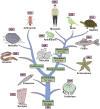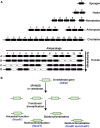Diversification and Functional Evolution of HOX Proteins
- PMID: 35646905
- PMCID: PMC9136108
- DOI: 10.3389/fcell.2022.798812
Diversification and Functional Evolution of HOX Proteins
Abstract
Gene duplication and divergence is a major contributor to the generation of morphological diversity and the emergence of novel features in vertebrates during evolution. The availability of sequenced genomes has facilitated our understanding of the evolution of genes and regulatory elements. However, progress in understanding conservation and divergence in the function of proteins has been slow and mainly assessed by comparing protein sequences in combination with in vitro analyses. These approaches help to classify proteins into different families and sub-families, such as distinct types of transcription factors, but how protein function varies within a gene family is less well understood. Some studies have explored the functional evolution of closely related proteins and important insights have begun to emerge. In this review, we will provide a general overview of gene duplication and functional divergence and then focus on the functional evolution of HOX proteins to illustrate evolutionary changes underlying diversification and their role in animal evolution.
Keywords: Drosophila; HOX proteins; gene duplication and divergence; mouse; protein evolution.
Copyright © 2022 Singh and Krumlauf.
Conflict of interest statement
The authors declare that the research was conducted in the absence of any commercial or financial relationships that could be construed as a potential conflict of interest.
Figures





Similar articles
-
Evolution of a transcriptional repression domain in an insect Hox protein.Nature. 2002 Feb 21;415(6874):910-3. doi: 10.1038/nature717. Epub 2002 Feb 6. Nature. 2002. PMID: 11859369
-
Gene duplication and the origins of morphological complexity in pancrustacean eyes, a genomic approach.BMC Evol Biol. 2010 Apr 30;10:123. doi: 10.1186/1471-2148-10-123. BMC Evol Biol. 2010. PMID: 20433736 Free PMC article.
-
Ultrabithorax function in butterfly wings and the evolution of insect wing patterns.Curr Biol. 1999 Feb 11;9(3):109-15. doi: 10.1016/s0960-9822(99)80064-5. Curr Biol. 1999. PMID: 10021383
-
Hox gene evolution: multiple mechanisms contributing to evolutionary novelties.Ann N Y Acad Sci. 2012 May;1256:15-32. doi: 10.1111/j.1749-6632.2011.06385.x. Epub 2012 Feb 9. Ann N Y Acad Sci. 2012. PMID: 22320178 Review.
-
Shaping segments: Hox gene function in the genomic age.Bioessays. 2008 Oct;30(10):965-79. doi: 10.1002/bies.20823. Bioessays. 2008. PMID: 18798525 Review.
Cited by
-
Paralog Explorer: A resource for mining information about paralogs in common research organisms.Comput Struct Biotechnol J. 2022 Nov 24;20:6570-6577. doi: 10.1016/j.csbj.2022.11.041. eCollection 2022. Comput Struct Biotechnol J. 2022. PMID: 36467589 Free PMC article.
-
Problems with Paralogs: The Promise and Challenges of Gene Duplicates in Evo-Devo Research.Integr Comp Biol. 2024 Sep 17;64(2):556-564. doi: 10.1093/icb/icae009. Integr Comp Biol. 2024. PMID: 38565319 Free PMC article. Review.
-
Development necessitates evolutionarily conserved factors.Sci Rep. 2025 Mar 22;15(1):9910. doi: 10.1038/s41598-025-92541-4. Sci Rep. 2025. PMID: 40121259 Free PMC article.
-
Linking Vertebrate Gene Duplications to the New Head Hypothesis.Biology (Basel). 2023 Sep 6;12(9):1213. doi: 10.3390/biology12091213. Biology (Basel). 2023. PMID: 37759612 Free PMC article. Review.
-
Role of the Hox Genes, Sex combs reduced, Fushi tarazu and Antennapedia, in Leg Development of the Spider Mite Tetranychus urticae.Int J Mol Sci. 2023 Jun 20;24(12):10391. doi: 10.3390/ijms241210391. Int J Mol Sci. 2023. PMID: 37373537 Free PMC article.
References
Publication types
LinkOut - more resources
Full Text Sources
Molecular Biology Databases

